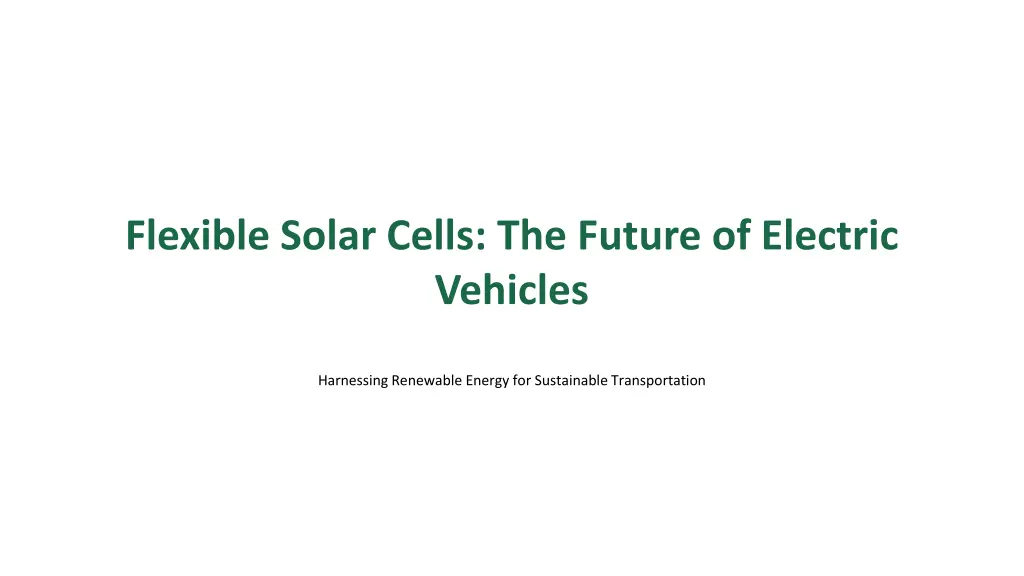
Revolutionizing Electric Vehicles with Flexible Solar Cells
"Discover the potential of flexible solar cells in revolutionizing electric vehicles (EVs), offering enhanced energy efficiency, greater driving ranges, and seamless integration. Explore various types, advantages, challenges, and integration methods of these innovative solar cells for sustainable transportation."
Download Presentation

Please find below an Image/Link to download the presentation.
The content on the website is provided AS IS for your information and personal use only. It may not be sold, licensed, or shared on other websites without obtaining consent from the author. If you encounter any issues during the download, it is possible that the publisher has removed the file from their server.
You are allowed to download the files provided on this website for personal or commercial use, subject to the condition that they are used lawfully. All files are the property of their respective owners.
The content on the website is provided AS IS for your information and personal use only. It may not be sold, licensed, or shared on other websites without obtaining consent from the author.
E N D
Presentation Transcript
Flexible Solar Cells: The Future of Electric Vehicles Harnessing Renewable Energy for Sustainable Transportation
01 The Rise of Flexible Solar Cells Table of Contents 02 Types of Flexible Solar Cells 03 Advantages of Flexible Solar Cells 04 Challenges Faced by Flexible Solar Cells 05 Integrating Flexible Solar Cells in EVs 06 Efficiency Improvements Required 07 Durability Considerations 08 Research Directions for the Future 09 The Road Ahead for Flexible Solar Cells 10 Thank You!
1 The Rise of Flexible Solar Cells The urgencyfor renewable energysolutions in vehicles is at an all-time high. Flexible solar cells present a groundbreaking technology for electric vehicles (EVs). They promise enhanced energy efficiency and greater driving ranges. Their lightweight and adaptable nature makes them ideal for vehicle integration. This innovation could revolutionize how we think about EV power sources.
2 Types of Flexible Solar Cells Various flexible solar cell technologies are being explored for EV applications. Organic solar cells offer lightweight and flexibility despite lower efficiency. Dye-sensitized solar cells are known for their potential low production costs. Perovskite solar cells are gaining attention for their impressive efficiency rates. Thin-film technologies provide durabilityand flexibility in form.
3 Advantages of Flexible Solar Cells Flexible solar cells can be seamlessly integratedinto vehicle surfaces. They offer aesthetic flexibility, allowing for design innovation in EVs. Reduced weight contributes positively to the vehicle's overall efficiency. They can generate energy undervarious environmental conditions. Long-term energysavings and reduced dependence on fossil fuels.
4 Challenges Faced by Flexible Solar Cells Despite their potential, flexible solar cells face significant challenges. They often struggle with lower efficiencies compared to traditionalsolar cells. Durability and longevity in harsh automotive environments remain concerns. High production costs can hinderwidespread adoption. Furtherresearch is necessary to overcome these obstacles.
5 Integrating Flexible Solar Cells in EVs Integration methods are critical for maximizing energy generation. Innovative designs can utilize vehicle rooftops and surfaces effectively. Custom integration within the vehicle's framework enhances performance. Collaboration between engineers and designers is essential for success. Real-world testing and prototypes are key to understanding viability.
6 Efficiency Improvements Required Significant advancements in photovoltaic materials are necessary. Research into hybridtechnologies could boost energy conversion rates. Improved electronics and energystorage solutions are vital. Addressing the efficiency gap is crucial for market acceptance. Continuous innovation will drive the evolution of flexible solar technology.
7 Durability Considerations Effective protective measures are needed against environmental wear. Testing for resistance to temperature, moisture, and mechanical stress is crucial. Longer-lasting materials can ensure reliabilityin automotive uses. A focus on manufacturing quality can enhance product life spans. Durability is paramount for gaining consumer trust and widespread adoption.
8 Research Directions for the Future A holistic approach to energymanagement in EVs is imperative. Exploring multi-layeredsolar cell structures could maximize space use. Investigating novel materials will foster innovative solutions. Collaboration among researchers, industryplayers, and policymakers is crucial. Driving forward research ensures flexibility gains a central role in EV power.
9 The Road Ahead for Flexible Solar Cells The path to integration faces hurdles but holds immense potential. Increased interest and investment in renewable technologies pave the way. Flexible solar cells may lead to self-sustaining electric vehicles. Innovators play a key role in shaping the future of EV energysolutions. A cleaner, sustainable world is within reach throughthese advancements.
10 Thank You! Thank you for your attention to this presentation! Together, we can pave the way for innovative energysolutions. Embrace the future of electric vehicles powered by renewable energy. Your thoughts and questions are welcome! Let's continue the conversation towards sustainability.
